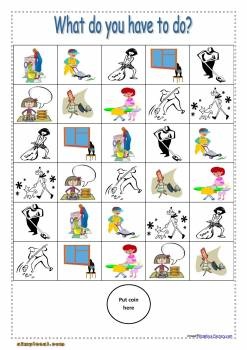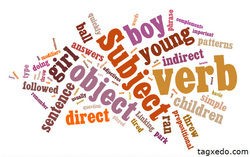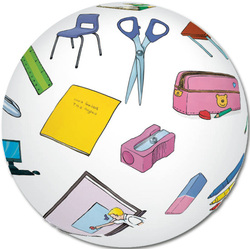
It has hard to believe that my time working with B (as well as with the rest of my class) is coming to a close. The past few weeks have really shown me what it can be like in my own classroom if I have another ESL student.
Unfortunately, I wasn't always able to work with B as often as I would have liked thanks to changes in scheduling and other events which interfered. My mentor and I both felt that it was important for B to stay in the classroom when they were participating in activities which he would be able to do and understand (especially Mathematics). This showed me just how difficult it can be as a regular teacher trying to aid an ESL student grow in language while trying to teach an entire class at the same time. It is possible to differentiate and give them different work than the others, but there isn't always time for that one on one instruction.
Overall I was very proud of B's progress. I noticed not only that he was willing to try new words and succeed in the language, but he was forming sentences by the end of our time together. Whether this was partially from our work together or simply from socializing with his peers is unknown however. According to the research, socialization was more likely the key factor, however, as he is constantly around English speakers and is fully immersed in the language while at school. The one on one instruction still proved to be useful, however, as he began to try to speak more to me during class time (including volunteering more answers) and would try to speak to me more frequently and openly than when we first began.
When I could, I tried to encourage B's language development during class time too. I gave him positive reinforcement whenever he tried to answer and modified work for him whenever possible (for example, on a math worksheet, he was not expected to answer word problems without help. He was also constantly given explanations using lots of visuals and gestures.) Although I haven't found much research to back me up on this, I do feel that my experiences with French definitely helped me to help B. Knowing how English students feel in French class and some of the activities which help my students, I was able to adapt these to fit an English lesson.
I can see the pros and cons to working with ESL students in the classroom vs one on one or using the pull-out strategy. While they require constant attention and support as well as structured language lessons, they also require class time with the rest of the class so they can socialize as well as keep up with the work expected of their grade levels.
If I was a teacher working with B in a classroom for the full year, I most likely would have given him a proficiency test to show his work a little better. We do have worksheets and a small workbook which shows what he completed, but I felt that testing would not prove useful for one small topic in such a small period of time. I would also attempt to set-up a program in which he would work in class on topics such as Mathematics, Science, and Social Studies, but would spend English working on a word set in English. The word sets would be pulled most likely from the French curriculum but adapted to fit English needs. This takes some of the guess work out of it and provides a structured
unit for the student to follow. Ideally there would be one on one work whenever possible, but without an aid, this is not always possible. I would also encourage the class to work with B (or any other ESL student) on playing language games and encouraging his vocabulary growth. This could be done in a rotation or as sponge activities whenever student's work is done.
Overall, I feel that this project was extremely beneficial to my own growth as a teacher. I am much more aware of the challenges that face ESL students as well as teachers and feel that I would be more prepared to face a similar task in the future. I recognize that I was only able to cover a small portion of the huge topic of ESL, but it is a beginning for growth in an area that is (I believe based on statistics) only going to grow more and more important over the years.
Thank you for reading and following along with B's progress and our work together! I wish this website may help you in any future endeavors (as a beginning step/resource) with ESL students.
-Miss Gloge
Unfortunately, I wasn't always able to work with B as often as I would have liked thanks to changes in scheduling and other events which interfered. My mentor and I both felt that it was important for B to stay in the classroom when they were participating in activities which he would be able to do and understand (especially Mathematics). This showed me just how difficult it can be as a regular teacher trying to aid an ESL student grow in language while trying to teach an entire class at the same time. It is possible to differentiate and give them different work than the others, but there isn't always time for that one on one instruction.
Overall I was very proud of B's progress. I noticed not only that he was willing to try new words and succeed in the language, but he was forming sentences by the end of our time together. Whether this was partially from our work together or simply from socializing with his peers is unknown however. According to the research, socialization was more likely the key factor, however, as he is constantly around English speakers and is fully immersed in the language while at school. The one on one instruction still proved to be useful, however, as he began to try to speak more to me during class time (including volunteering more answers) and would try to speak to me more frequently and openly than when we first began.
When I could, I tried to encourage B's language development during class time too. I gave him positive reinforcement whenever he tried to answer and modified work for him whenever possible (for example, on a math worksheet, he was not expected to answer word problems without help. He was also constantly given explanations using lots of visuals and gestures.) Although I haven't found much research to back me up on this, I do feel that my experiences with French definitely helped me to help B. Knowing how English students feel in French class and some of the activities which help my students, I was able to adapt these to fit an English lesson.
I can see the pros and cons to working with ESL students in the classroom vs one on one or using the pull-out strategy. While they require constant attention and support as well as structured language lessons, they also require class time with the rest of the class so they can socialize as well as keep up with the work expected of their grade levels.
If I was a teacher working with B in a classroom for the full year, I most likely would have given him a proficiency test to show his work a little better. We do have worksheets and a small workbook which shows what he completed, but I felt that testing would not prove useful for one small topic in such a small period of time. I would also attempt to set-up a program in which he would work in class on topics such as Mathematics, Science, and Social Studies, but would spend English working on a word set in English. The word sets would be pulled most likely from the French curriculum but adapted to fit English needs. This takes some of the guess work out of it and provides a structured
unit for the student to follow. Ideally there would be one on one work whenever possible, but without an aid, this is not always possible. I would also encourage the class to work with B (or any other ESL student) on playing language games and encouraging his vocabulary growth. This could be done in a rotation or as sponge activities whenever student's work is done.
Overall, I feel that this project was extremely beneficial to my own growth as a teacher. I am much more aware of the challenges that face ESL students as well as teachers and feel that I would be more prepared to face a similar task in the future. I recognize that I was only able to cover a small portion of the huge topic of ESL, but it is a beginning for growth in an area that is (I believe based on statistics) only going to grow more and more important over the years.
Thank you for reading and following along with B's progress and our work together! I wish this website may help you in any future endeavors (as a beginning step/resource) with ESL students.
-Miss Gloge




 RSS Feed
RSS Feed